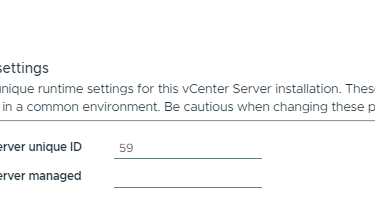vCenter ID and why its important
This is more of a "Did you know?" article. If you're managing a VMware environment with many different vCenter servers, it's a good idea to use unique vCenter IDs for each server. Here's why:
In VMware vSphere, the vCenter ID is a unique identifier associated with a vCenter Server instance. This ID is crucial for distinguishing different vCenter instances, especially in environments where multiple vCenter Servers are deployed. In this case we are talking about a scenario where two virtual machines can get the same mac adress.
VMware generates MAC addresses based on an Organizational Unique Identifier (OUI), a vCenter-specific identifier (the vCenter UUID), and a unique counter to ensure each VM within the vCenter has a unique MAC.
For example: for a MAC address like 00:50:56:AA:BB:CC:
00:50:56 is the VMware OUI.
AA represents the vCenter ID component.
BB:CC is a unique counter for each VM created under that vCenter.
OUI:
The Organizational Unique Identifier (OUI) in VMware is a three-byte identifier that is part of the MAC address for virtual network interfaces. This OUI is unique to VMware and helps identify network devices as VMware-originated.
UUID:
This is the vCenter ID, which can be found under vCenter --> configure --> general --> edit and select runtime settings. There you can see and change the vCenter ID if needed.
Unique counter:
The unique counter is typically a hexadecimal number, and the way VMware assigns it is based on different factors, including:
Range and Allocation by Host: The ESXi host generates this part by assigning numbers sequentially, ensuring uniqueness on that specific host
vCenter-Generated MACs: When a virtual machine is managed by vCenter, the counter includes identifiers that keep MAC addresses unique across hosts and clusters within that vCenter
How Duplicate vCenter IDs Cause Conflicts
As explained over if two vCenters share the same ID, the fourth byte (derived from the vCenter ID) will be the same, causing both vCenters to use the same starting MAC address prefix (00:50:56:AA). As each VM is created, both vCenters will also increment the counter in the last two bytes, but since they share the same base prefix (00:50:56:AA), duplicate MAC addresses can still occur across the VMs.


VirtualViking
Plundering the Old Ways, Automating the New!
Tech
© 2024. All rights reserved.

